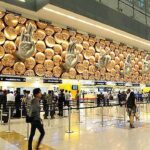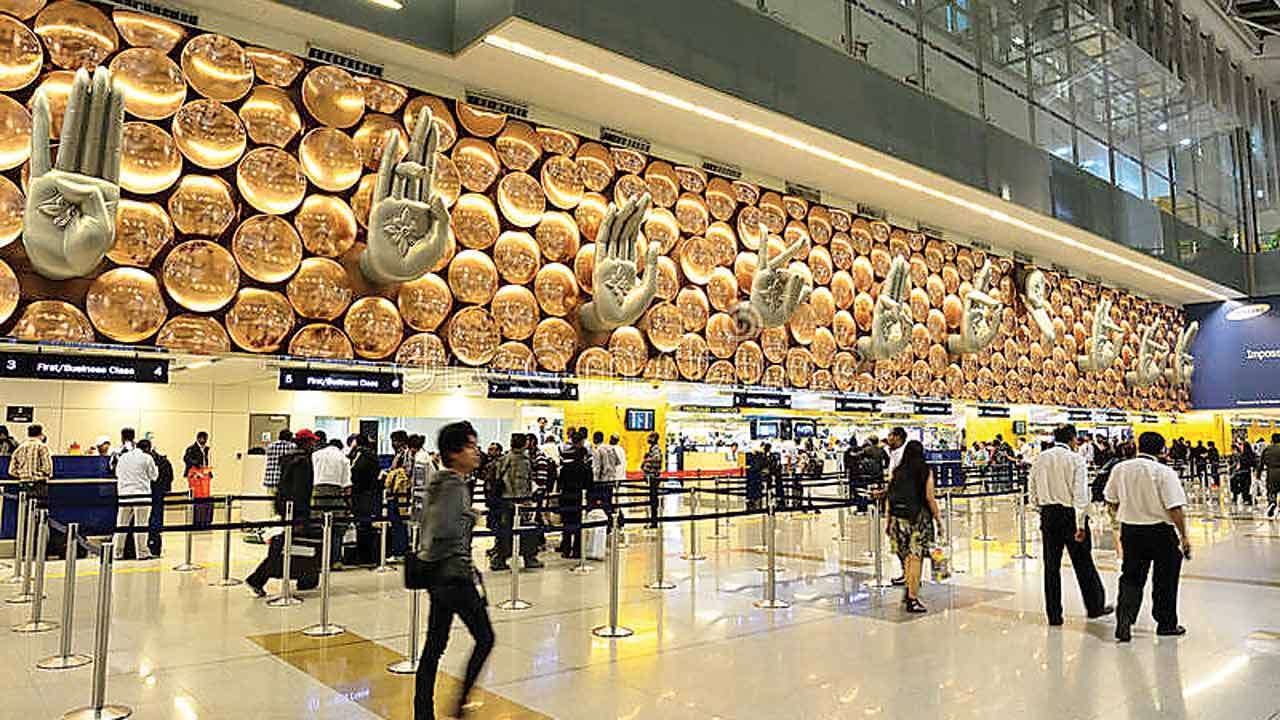In a major embarrassment for Indian airport security, a British national named Fitz Patrick walked out of Delhi’s Indira Gandhi International Airport (IGI) without passing through immigration clearance. The incident, which occurred in late October 2025, has raised alarming questions about the efficiency of airport surveillance systems, immigration controls, and inter-agency coordination at one of the world’s busiest airports.
Patrick, who was reportedly facing deportation, managed to leave the terminal unnoticed, sparking a full-scale manhunt across Delhi and the National Capital Region (NCR). Authorities are now investigating how such a lapse occurred under the watch of multiple security agencies.
The Timeline of Events: How the Escape Happened
The chain of events unfolded on October 28, 2025, when Fitz Patrick arrived in Delhi on Air India flight AI 333 from Bangkok. He was scheduled to board a connecting flight to London Heathrow later that day. However, Patrick missed the connecting flight, a seemingly minor incident that quickly spiraled into a major security failure.
Instead of waiting in the designated international transit lounge, Patrick reportedly found a way to bypass the secure area and exit through Gate 4 of the arrival terminal, without any immigration stamp or verification.
- Arrival Time: Around 11:45 a.m.
- Transit Flight Missed: London-bound Air India service at approximately 2:10 p.m.
- Discovery of Absence: Next morning, on October 29, 2025, when airline and immigration officials did not find his exit record.
CCTV footage later revealed that Patrick was seen near the e-Visa counter around 7:30 a.m., where he appeared to lift the security flap gate and slip through. From there, he walked out of the terminal into the city, leaving authorities scrambling to locate him.
How Could He Leave Without a Gate Pass or Clearance?
Airport security experts describe IGI’s international-to-international transfer corridor as a restricted, closely monitored area. Every passenger connecting between international flights must remain in the air-side zone until boarding.
In this case, Patrick’s missed connection should have prompted either:
- Immediate escort to an airline help desk or holding area, or
- Immigration clearance under supervision, since he could not remain indefinitely in the transit zone.
However, preliminary findings suggest no staff member accompanied him after the missed flight. Without supervision, Patrick managed to blend with arriving passengers, exploiting what investigators describe as a “human lapse” at the gate where staff momentarily stepped away.
The Discovery and Response
When the British national failed to show up for his connecting flight, airline staff assumed he might have rebooked or been detained for visa formalities. It was only during a routine headcount at immigration the next day that officials realized his records showed no departure, arrival, or clearance.
Authorities immediately checked:
- Immigration counters,
- Airline passenger manifests, and
- Closed-circuit footage from the arrival terminal.
The shocking revelation came when CCTV cameras showed the man lifting a small barrier at the immigration area, walking briskly toward Gate 4, and vanishing into the public zone.
Multi-Agency Hunt and Investigation
Following the breach, a multi-agency investigation was launched, involving:
- Bureau of Immigration (BoI),
- Central Industrial Security Force (CISF),
- Delhi Police’s Airport Unit, and
- Intelligence Bureau (IB) personnel.
An FIR has been filed under the Foreigners Act and relevant sections of the Indian Penal Code (IPC) for illegal entry and evasion of immigration procedures. Officials have circulated Patrick’s photograph to:
- Delhi Metro, railway stations, and border checkpoints,
- Hotels and guesthouses, and
- Airlines and embassies across India.
Despite widespread alerts, as of the latest update, Patrick remains untraced, prompting authorities to question whether he might have left Delhi using alternate transport or even exited the country illegally.
Security Loophole: How Did IGI’s Systems Fail?
This case exposes several vulnerabilities in airport security design and protocol execution. Some of the critical questions investigators are asking include:
- Was the CCTV coverage comprehensive?
Preliminary reports suggest that blind spots near immigration counters may have allowed Patrick to move undetected for several minutes. - Were staff adequately trained?
Ground personnel might not have received specific instructions for handling missed-connection passengers, especially those under deportation status. - Who monitors transit zones?
The CISF oversees security screening but not the immigration area itself, which falls under Bureau of Immigration. This jurisdiction overlap often creates grey areas in responsibility. - Were exit gates physically secured?
Gate 4, which Patrick allegedly used, may have been left unmonitored or unlocked temporarily during maintenance or passenger flow.
The Legal and Immigration Angle
Sources indicate that Fitz Patrick’s visa situation was irregular. He had not applied for an Indian entry visa, as his ticket and itinerary designated him for international transit only. His escape into Delhi thus constitutes an unauthorized entry into Indian territory, violating Section 14 of the Foreigners Act, 1946.
Moreover, he was reportedly scheduled for deportation from Thailand to the UK and had only a transit stop in Delhi. If confirmed, this would mean Patrick was already under deportation custody and should have been escorted throughout his layover.
The UK High Commission has been notified and is cooperating with Indian authorities to verify his identity and assist in the search.
Reactions from Authorities and Experts
Security officials described the breach as a “serious procedural failure”. A senior CISF officer stated that the area of escape was not under CISF’s immediate control, as the immigration desks are managed by BoI.
An officer from the Bureau of Immigration admitted that procedural gaps may have enabled Patrick’s exit:
“It appears to be a combination of human negligence and infrastructural vulnerability. We are reviewing protocols to ensure such incidents never recur.”
Aviation security analysts have pointed out that airports often rely too heavily on technology, assuming CCTV and access control will catch every irregularity. In reality, one inattentive moment by human personnel can undo multiple layers of security.
Impact on Airport Security and Policy
The incident is expected to trigger a comprehensive review of transit passenger management systems at Indian airports. Key focus areas likely to be revised include:
- Stricter Monitoring of Missed-Connection Passengers
Airlines will now be required to immediately report any passenger who misses a connecting flight to immigration authorities. - Revised Standard Operating Procedures (SOPs)
Updated SOPs may mandate temporary detention or escorting of stranded international passengers until re-booking or immigration clearance. - Integrated Digital Tracking
Passenger movement data, including flight changes, will likely be digitally synchronized between airlines, immigration desks, and airport operations control rooms. - Cross-Agency Accountability
Future security audits may emphasize joint responsibility between CISF and BoI to prevent jurisdictional confusion.
Global Context: Airport Breaches Are Not Unique
While the Fitz Patrick incident has shocked Indian authorities, airport security breaches have occurred worldwide. In 2023, a passenger in the United States boarded a flight without a boarding pass, and in 2024, an undocumented traveler at Dubai Airport hid in a storage compartment to avoid deportation.
Experts note that such breaches typically occur due to oversight during shift changes, transit delays, or crowd congestion. However, IGI’s scale and surveillance density make this particular escape especially concerning.
What We Know About Fitz Patrick
Though Indian agencies have not publicly disclosed full details for privacy reasons, reports suggest:
- He is a British national, mid-40s, traveling on passport number 55819 xx.
- He entered Thailand earlier in 2025 and was ordered deported to the UK for visa violations.
- Air India accepted him as a deportee passenger from Bangkok with Delhi as a transit stop before London.
- He had no valid Indian visa, thus making his movement outside the transit zone illegal.
- His last known location was captured on CCTV at Gate 4 of the arrival terminal around 7:32 a.m. on October 29.
Police are now exploring whether he may have had local contacts in Delhi who facilitated his disappearance.
Consequences and Accountability
The Ministry of Civil Aviation has ordered an internal review and sought explanations from both Air India and airport management. The Delhi Police’s crime branch is also probing whether any insider assistance helped Patrick escape.
Possible disciplinary actions may include:
- Suspension of immigration staff on duty during the incident,
- Review of CISF deployment near transfer gates, and
- Revision of Air India’s deportee handling policy.
Government sources have hinted at policy tightening, including biometric verification for all transit passengers, ensuring that anyone exiting without clearance immediately triggers an alarm.
Security Experts Weigh In
Aviation safety analyst Group Capt. S. K. Narang (Retd.) said:
“Airports depend on multi-layered systems — CCTV, physical barriers, and human supervision. When one layer fails, others should compensate. Here, all three failed simultaneously.”
Another expert from the Centre for Aviation Security Studies noted that immigration counters lack real-time alert systems, unlike check-in gates. He recommended that AI-driven motion tracking and facial recognition analytics be deployed in high-risk zones like transfer corridors.
The Public and Media Reaction
The story has gone viral across news and social media platforms. Keywords like “Delhi Airport escape,” “British man missing from IGI,” and “Fitz Patrick Delhi immigration lapse” have been trending on Google in India and the UK.
Public sentiment online has been largely critical, with citizens questioning how someone could simply “walk out” of a secure zone in one of Asia’s top airports. Some commentators have drawn comparisons to Hollywood-style escape plots, while others highlight the need for greater accountability in India’s aviation administration.
Broader Lessons for India’s Aviation Security
The Fitz Patrick episode has become a case study in procedural oversight. Experts say it underscores five urgent lessons for India’s airport system:
- Transit Zone Vulnerability — Missed-connection passengers require real-time tracking.
- Human-Tech Coordination — Cameras alone can’t replace vigilant officers.
- Inter-Agency Jurisdiction Clarity — Security and immigration must operate under a unified command protocol.
- Training for Contingencies — Staff need simulations for rare cases like deportee layovers or long transit delays.
- Data Integration — A central platform connecting immigration, airline, and security data is crucial.
The Hunt Continues
As of early November 2025, police teams have extended their search to Noida, Gurugram, and other NCR towns. Immigration alerts have been issued to all land border crossings and airports to prevent any possible exit.
Authorities suspect Patrick might have sought refuge in guesthouses or short-term rentals in Delhi’s Paharganj area, a hotspot for foreign backpackers. Investigators are scanning hotel registers and CCTV feeds to trace him.In a major embarrassment for Indian airport security, a British national named Fitz Patrick walked out of Delhi’s Indira Gandhi International Airport (IGI) without passing through immigration clearance. The incident, which occurred in late October 2025, has raised alarming questions about the efficiency of airport surveillance systems, immigration controls, and inter-agency coordination at one of the world’s busiest airports.
Patrick, who was reportedly facing deportation, managed to leave the terminal unnoticed, sparking a full-scale manhunt across Delhi and the National Capital Region (NCR). Authorities are now investigating how such a lapse occurred under the watch of multiple security agencies.
The Timeline of Events: How the Escape Happened
The chain of events unfolded on October 28, 2025, when Fitz Patrick arrived in Delhi on Air India flight AI 333 from Bangkok. He was scheduled to board a connecting flight to London Heathrow later that day. However, Patrick missed the connecting flight, a seemingly minor incident that quickly spiraled into a major security failure.
Instead of waiting in the designated international transit lounge, Patrick reportedly found a way to bypass the secure area and exit through Gate 4 of the arrival terminal, without any immigration stamp or verification.
- Arrival Time: Around 11:45 a.m.
- Transit Flight Missed: London-bound Air India service at approximately 2:10 p.m.
- Discovery of Absence: Next morning, on October 29, 2025, when airline and immigration officials did not find his exit record.
CCTV footage later revealed that Patrick was seen near the e-Visa counter around 7:30 a.m., where he appeared to lift the security flap gate and slip through. From there, he walked out of the terminal into the city, leaving authorities scrambling to locate him.
How Could He Leave Without a Gate Pass or Clearance?
Airport security experts describe IGI’s international-to-international transfer corridor as a restricted, closely monitored area. Every passenger connecting between international flights must remain in the air-side zone until boarding.
In this case, Patrick’s missed connection should have prompted either:
- Immediate escort to an airline help desk or holding area, or
- Immigration clearance under supervision, since he could not remain indefinitely in the transit zone.
However, preliminary findings suggest no staff member accompanied him after the missed flight. Without supervision, Patrick managed to blend with arriving passengers, exploiting what investigators describe as a “human lapse” at the gate where staff momentarily stepped away.
The Discovery and Response
When the British national failed to show up for his connecting flight, airline staff assumed he might have rebooked or been detained for visa formalities. It was only during a routine headcount at immigration the next day that officials realized his records showed no departure, arrival, or clearance.
Authorities immediately checked:
- Immigration counters,
- Airline passenger manifests, and
- Closed-circuit footage from the arrival terminal.
The shocking revelation came when CCTV cameras showed the man lifting a small barrier at the immigration area, walking briskly toward Gate 4, and vanishing into the public zone.
Multi-Agency Hunt and Investigation
Following the breach, a multi-agency investigation was launched, involving:
- Bureau of Immigration (BoI),
- Central Industrial Security Force (CISF),
- Delhi Police’s Airport Unit, and
- Intelligence Bureau (IB) personnel.
An FIR has been filed under the Foreigners Act and relevant sections of the Indian Penal Code (IPC) for illegal entry and evasion of immigration procedures. Officials have circulated Patrick’s photograph to:
- Delhi Metro, railway stations, and border checkpoints,
- Hotels and guesthouses, and
- Airlines and embassies across India.
Despite widespread alerts, as of the latest update, Patrick remains untraced, prompting authorities to question whether he might have left Delhi using alternate transport or even exited the country illegally.
Security Loophole: How Did IGI’s Systems Fail?
This case exposes several vulnerabilities in airport security design and protocol execution. Some of the critical questions investigators are asking include:
- Was the CCTV coverage comprehensive?
Preliminary reports suggest that blind spots near immigration counters may have allowed Patrick to move undetected for several minutes. - Were staff adequately trained?
Ground personnel might not have received specific instructions for handling missed-connection passengers, especially those under deportation status. - Who monitors transit zones?
The CISF oversees security screening but not the immigration area itself, which falls under Bureau of Immigration. This jurisdiction overlap often creates grey areas in responsibility. - Were exit gates physically secured?
Gate 4, which Patrick allegedly used, may have been left unmonitored or unlocked temporarily during maintenance or passenger flow.
The Legal and Immigration Angle
Sources indicate that Fitz Patrick’s visa situation was irregular. He had not applied for an Indian entry visa, as his ticket and itinerary designated him for international transit only. His escape into Delhi thus constitutes an unauthorized entry into Indian territory, violating Section 14 of the Foreigners Act, 1946.
Moreover, he was reportedly scheduled for deportation from Thailand to the UK and had only a transit stop in Delhi. If confirmed, this would mean Patrick was already under deportation custody and should have been escorted throughout his layover.
The UK High Commission has been notified and is cooperating with Indian authorities to verify his identity and assist in the search.
Reactions from Authorities and Experts
Security officials described the breach as a “serious procedural failure”. A senior CISF officer stated that the area of escape was not under CISF’s immediate control, as the immigration desks are managed by BoI.
An officer from the Bureau of Immigration admitted that procedural gaps may have enabled Patrick’s exit:
“It appears to be a combination of human negligence and infrastructural vulnerability. We are reviewing protocols to ensure such incidents never recur.”
Aviation security analysts have pointed out that airports often rely too heavily on technology, assuming CCTV and access control will catch every irregularity. In reality, one inattentive moment by human personnel can undo multiple layers of security.
Impact on Airport Security and Policy
The incident is expected to trigger a comprehensive review of transit passenger management systems at Indian airports. Key focus areas likely to be revised include:
- Stricter Monitoring of Missed-Connection Passengers
Airlines will now be required to immediately report any passenger who misses a connecting flight to immigration authorities. - Revised Standard Operating Procedures (SOPs)
Updated SOPs may mandate temporary detention or escorting of stranded international passengers until re-booking or immigration clearance. - Integrated Digital Tracking
Passenger movement data, including flight changes, will likely be digitally synchronized between airlines, immigration desks, and airport operations control rooms. - Cross-Agency Accountability
Future security audits may emphasize joint responsibility between CISF and BoI to prevent jurisdictional confusion.
Global Context: Airport Breaches Are Not Unique
While the Fitz Patrick incident has shocked Indian authorities, airport security breaches have occurred worldwide. In 2023, a passenger in the United States boarded a flight without a boarding pass, and in 2024, an undocumented traveler at Dubai Airport hid in a storage compartment to avoid deportation.
Experts note that such breaches typically occur due to oversight during shift changes, transit delays, or crowd congestion. However, IGI’s scale and surveillance density make this particular escape especially concerning.
What We Know About Fitz Patrick
Though Indian agencies have not publicly disclosed full details for privacy reasons, reports suggest:
- He is a British national, mid-40s, traveling on passport number 55819 xx.
- He entered Thailand earlier in 2025 and was ordered deported to the UK for visa violations.
- Air India accepted him as a deportee passenger from Bangkok with Delhi as a transit stop before London.
- He had no valid Indian visa, thus making his movement outside the transit zone illegal.
- His last known location was captured on CCTV at Gate 4 of the arrival terminal around 7:32 a.m. on October 29.
Police are now exploring whether he may have had local contacts in Delhi who facilitated his disappearance.
Consequences and Accountability
The Ministry of Civil Aviation has ordered an internal review and sought explanations from both Air India and airport management. The Delhi Police’s crime branch is also probing whether any insider assistance helped Patrick escape.
Possible disciplinary actions may include:
- Suspension of immigration staff on duty during the incident,
- Review of CISF deployment near transfer gates, and
- Revision of Air India’s deportee handling policy.
Government sources have hinted at policy tightening, including biometric verification for all transit passengers, ensuring that anyone exiting without clearance immediately triggers an alarm.
Security Experts Weigh In
Aviation safety analyst Group Capt. S. K. Narang (Retd.) said:
“Airports depend on multi-layered systems — CCTV, physical barriers, and human supervision. When one layer fails, others should compensate. Here, all three failed simultaneously.”
Another expert from the Centre for Aviation Security Studies noted that immigration counters lack real-time alert systems, unlike check-in gates. He recommended that AI-driven motion tracking and facial recognition analytics be deployed in high-risk zones like transfer corridors.
The Public and Media Reaction
The story has gone viral across news and social media platforms. Keywords like “Delhi Airport escape,” “British man missing from IGI,” and “Fitz Patrick Delhi immigration lapse” have been trending on Google in India and the UK.
Public sentiment online has been largely critical, with citizens questioning how someone could simply “walk out” of a secure zone in one of Asia’s top airports. Some commentators have drawn comparisons to Hollywood-style escape plots, while others highlight the need for greater accountability in India’s aviation administration.
Broader Lessons for India’s Aviation Security
The Fitz Patrick episode has become a case study in procedural oversight. Experts say it underscores five urgent lessons for India’s airport system:
- Transit Zone Vulnerability — Missed-connection passengers require real-time tracking.
- Human-Tech Coordination — Cameras alone can’t replace vigilant officers.
- Inter-Agency Jurisdiction Clarity — Security and immigration must operate under a unified command protocol.
- Training for Contingencies — Staff need simulations for rare cases like deportee layovers or long transit delays.
- Data Integration — A central platform connecting immigration, airline, and security data is crucial.
The Hunt Continues
As of early November 2025, police teams have extended their search to Noida, Gurugram, and other NCR towns. Immigration alerts have been issued to all land border crossings and airports to prevent any possible exit.
Authorities suspect Patrick might have sought refuge in guesthouses or short-term rentals in Delhi’s Paharganj area, a hotspot for foreign backpackers. Investigators are scanning hotel registers and CCTV feeds to trace him.










